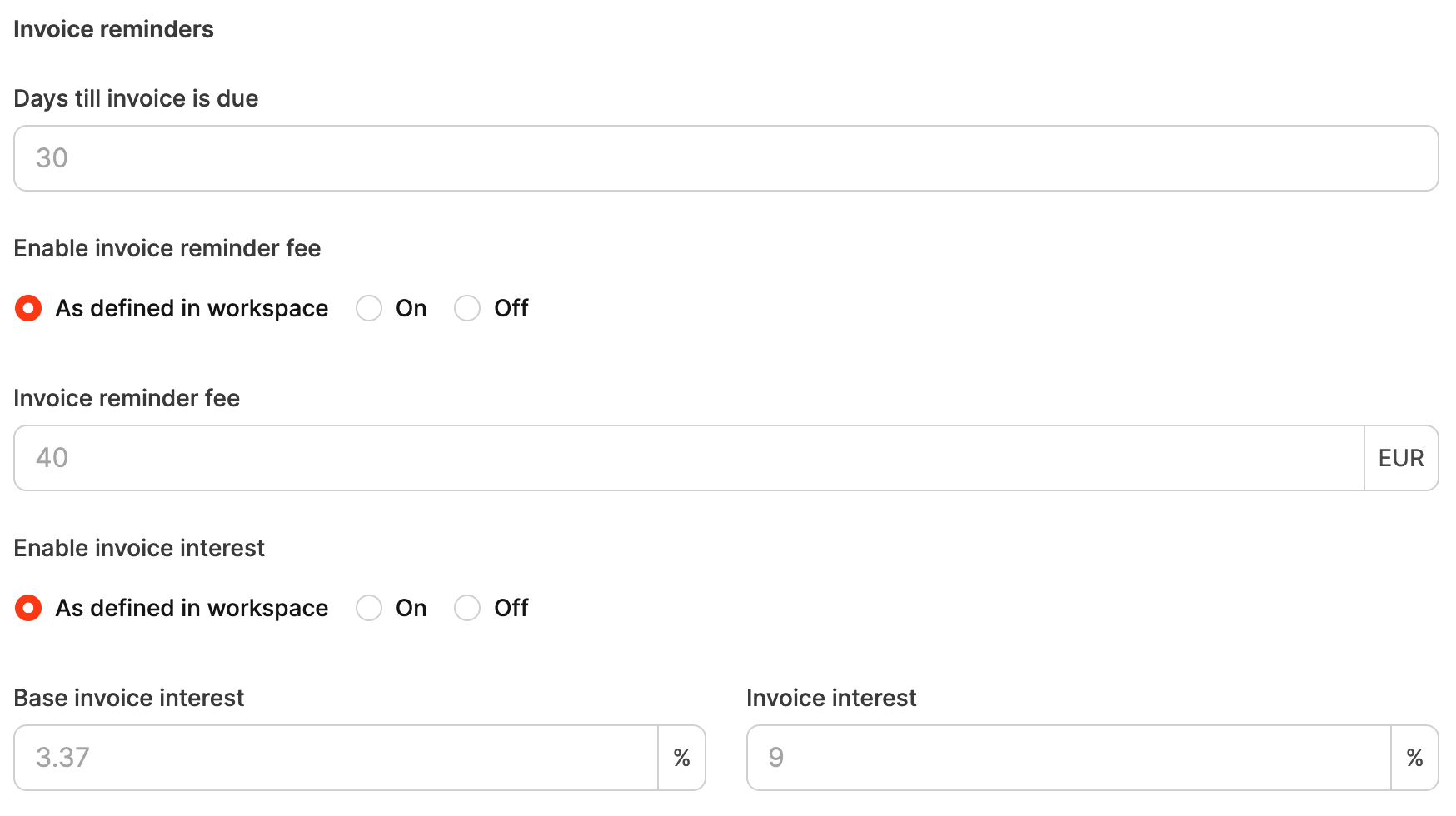In the Invoice Settings section, you define organization-specific billing parameters that determine how invoices, reminders, and cancellations are created for a particular organization. These settings can override the general workspace rules to allow customer-specific payment terms and texts.

Where to find:
Go to Organizations → [Select Organization] → Settings → Invoice Settings.
In the organization settings, you can make it so that specific customers have different billing or reminder rules than the standard for the workspace. This is especially helpful if you work with different types of customers, contract types, or payment terms.
The workspace default for billing options: Billing
Large companies, corporations, or public clients often have their own contract terms.
Longer payment terms (e.g. 60 instead of 30 days)
No reminder fees or late interest
Special contacts or invoice layouts
With organization-specific settings, you can map these requirements exactly, without changing your general workspace rules.
Not every customer is billed under the same conditions.
Existing customers often get better conditions.
Project-based customers pay different hourly rates depending on scope or industry.
Long-term partners get fixed flat rates, while ad-hoc customers have higher hourly rates.
A customer-specific hourly rate in the organization settings makes sure all billable services are automatically rated at the right rate – no manual adjustment needed when creating invoices.
For strategically important customers, it can make sense to make reminders a bit more gentle:
Disable reminder fees
Friendlier reminder messages
Longer payment terms
This way, the customer relationship stays positive—even if payments are sometimes late.
For customers with unreliable payment behavior, you can set stricter reminder rules:
Shorter payment terms
Earlier reminders
Higher reminder fees or interest surcharges
This helps payments come in faster and reduces the risk of unpaid invoices.
For international projects, you can take country-specific details into account, like:
Different interest rates or dunning periods
Invoice currency and language
Varying legal requirements
This way, your invoicing stays compliant and easy to understand—no matter the customer’s country.

Hourly rate: Sets the individual hourly rate for this organization. This value is used for all billable times.
Invoice language: Language used to generate invoices (like German or English).
The workspace default for billing options: Billing

Days until due: Number of days after invoice date until the payment is due.
Enable late fee: Controls if late fees are charged. Options:
Inherited from workspace settings
Enabled
Disabled
Late fee: Amount charged for overdue invoices.
Enable interest on arrears: Controls if interest is charged on overdue invoices.
Inherited from workspace settings
Enabled
Disabled
Base interest rate: Basis for interest calculation.
Interest on arrears: Percentage added to the base interest rate.
Base interest rate
The base interest rate is set by the European Central Bank or the German Bundesbank and serves as a reference value for calculating default interest. It changes every six months (on January 1st and July 1st).
Default interest
Default interest is the surcharge on the base interest rate, that a debtor has to pay if they don't pay an invoice on time.
As a rule (according to BGB §288):
Private customers: base interest rate + 5 %
Businesses: base interest rate + 9 %
In Leadtime, you can set both values individually to apply the right interest rates for late payments depending on customer type or contract.
These text blocks appear automatically on invoices and reminders and can be customised individually.

Invoice greeting: This is the template for the greeting on your invoices. It gets added automatically. You can edit it to address your customers personally.
Invoice footer: Here you can add a text that shows up as a footer on every invoice. This could be payment instructions or your bank details.
Reminder fee warning: This template is used when the first reminder is due. It lets your customer know about any reminder fees or interest if the invoice isn't paid on time.
Greeting of the first reminder: This text is used in the first reminder to politely let the customer know that the payment deadline has been missed.
Footer of the first reminder: This text appears at the end of the first reminder and explains which fees and interest will apply if the invoice is still unpaid.
Greeting of the second reminder: This text is intended for the second reminder. It lets the customer know that this is the final reminder.
Footer of the second reminder: The closing text of the second reminder, which tells the customer about possible legal steps if the payment stays outstanding.
Content of the cancellation: This text is used when an invoice is cancelled. It explains that the invoice has been withdrawn and no payment is needed anymore.
Macro | Description | Example output |
#dear | Automatic greeting based on recipient | Dear Mr. Schneider |
#senderName | Sender's name | Felix Schneider |
#senderPosition | Sender's position | Managing Director |
#senderNameAndPosition | Name and position combined | Felix Schneider, Managing Director |
#todayDate | Today's date | 22.10.2025 |
#clientCompanyName | Client organization's name | HorizonWorks |
#contactPerson | Primary contact person | Sarah Weber |
#invoiceNumber | Invoice number | INV-0241 |
#invoiceTotal | Total invoice amount | 4,200 € |
#dueDate | Due date | 05.11.2025 |
#accountNumber | Sender's payment account | DE12 3456 7890 1234 5678 90 |
#reminderPenalty | Reminder fee | 40 € |
#interestPercent | Default interest rate | 9 % |
#overdueInterestPercent | Interest rate for overdue payments | 11 % |
#fullTotal | Total including interest and fees | 4,289 € |
#signature | Sender's digital signature | — |
The workspace standard for the billing options: Billing